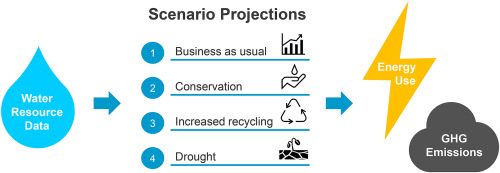Water Research ( IF 11.4 ) Pub Date : 2018-05-16 , DOI: 10.1016/j.watres.2018.05.012 Thomas P. Hendrickson , Maya Bruguera

|
California faces significant energy and water infrastructure planning challenges in response to a changing climate. Immediately following the most severe recorded drought, the state experienced one of its wettest water years in recorded history. Despite the recent severe wet weather, much of the state's critical groundwater systems have not recovered from the drought. The recent Sustainable Groundwater Management Act (SGMA) aims to eliminate future depletion risks, but may force California basins to seek alternative water sources by limiting groundwater withdrawals during droughts. These alternative water resources, such as recycled water or desalination, can have significantly higher energy demands in treatment and supply than local groundwater or surface water resources.
This research developed potential scenarios of water supply sources for five overdrafted groundwater basins, and modeled the impacts of these scenarios on energy demands and greenhouse gas (GHG) emissions for water supply systems. Our results reveal that energy demands and GHG emissions in different water supply scenarios can vary substantially between basins, but could increase statewide energy consumption as much as 2% and GHG emissions by 0.5. These results highlight the need to integrate these energy and GHG impacts into water resource management. Better understanding these considerations enables water supply planners to avoid potential unintended consequences (i.e., increased energy demands and GHG emissions) of enhancing drought resilience.
中文翻译:

加州地下水管理对能源和温室气体排放的影响
为了应对气候变化,加州面临着巨大的能源和水基础设施规划挑战。在有记录的最严重干旱之后,该州立即经历了有记录的历史中最湿的水年之一。尽管最近天气潮湿,但该州的许多关键地下水系统仍未从干旱中恢复过来。最近的《可持续地下水管理法案》(SGMA)旨在消除未来的枯竭风险,但可能会通过限制干旱期间的地下水抽取来迫使加利福尼亚盆地寻求替代水源。这些替代水资源,例如循环水或海水淡化,在处理和供应方面的能源需求可能比本地地下水或地表水资源要高得多。
这项研究开发了五个透水地下水盆地的水源潜在方案,并模拟了这些方案对供水系统的能源需求和温室气体(GHG)排放的影响。我们的结果表明,不同供水情景下的能源需求和温室气体排放量在流域之间可能存在很大差异,但可能使全州范围内的能源消耗增加2%,温室气体排放量增加0.5。这些结果强调了将这些能源和温室气体影响纳入水资源管理的必要性。更好地理解这些考虑因素,可使供水规划人员避免增强干旱抗灾力的潜在意想不到的后果(即,能源需求增加和温室气体排放量增加)。











































 京公网安备 11010802027423号
京公网安备 11010802027423号